Adventures of Don Juan
Adventures of Don Juan
Rating: ***
Origin: USA,1948
Director: Vincent Sherman
Source: Warner Bros. DVD
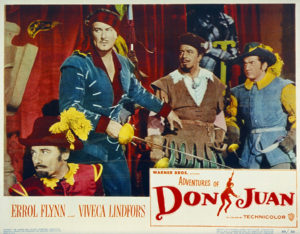
Errol Flynn had given up doing swashbucklers after The Sea Hawk (1940), but with the revival of the historical adventure genre in the late ‘40s, Warner Bros. gave him a sword and put him back in trunk-hose for The Adventures of Don Juan. But it must be said, Flynn doesn’t seem entirely comfortable in the rôle of Don Juan de Maraña, the scandal-plagued womanizing rogue who is forced to give up his naughty ways and turn over a new leaf. After disgracing himself picking forbidden fruit at the English Court, Don Juan is summoned back to Madrid by the Queen of Spain (Viveca Lindfors) and commanded to reform—which he does, improbably, because his soul is purified for the first time by his true love … for the queen. (No, really.) Purged of the rakish qualities that made the character distinctive, Don Juan becomes a conventional noble who gets entangled in conventional court intrigues, saving the queen from a conventional treasonous minister by foiling his conventional plot at the last minute—as usual.
Flynn seems vaguely embarrassed by all this, while Swedish beauty Lindfors looks majestic, but seems to have just two emotional states, detached or petulant. Only Robert Douglas as the villainous Duke de Lorca seems to get his teeth into his part, oozing arrogance and cruelty, and going out in fine style in an epic duel with Don Juan on the palace’s grand staircase.
Don Juan, of course, is the famous antihero of a long tradition of stories, operas, and epic poems, but strangely this movie draws on almost none of that rich background, with one curious exception: that final duel takes place at the foot of a colossal armored statue of The Commander, the figure of ultimate justice that appears at the end of so many tales of Don Juan. Why that, and nothing else? Who knows? At least there’s a fine surging score by Max Steiner, the Oscar-winning costumes are excellent, production values are high, and the fencing is better than usual. But go back and compare this merely-adequate film with John Barrymore’s stunning Don Juan (1926) and you’ll shake your head ruefully.
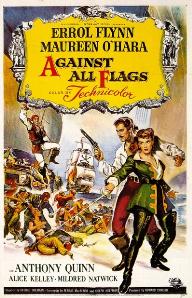 I know it isn’t true, but I like to think that in the late 1990s, when the wonks at Disney were considering what tone to take for the movie they planned to base on their Pirates of the Caribbean theme-park ride, they watched a lot of old pirate movies, saw Against All Flags, and said, “That’s it!” Though a few historical names appear in it, this is a story set in an Age of Piracy beyond history, or at least no closer than next door to it. The bustling Madagascar port of Libertatia is run by the Captains of the Coast, a diverse gang that includes the Latino Roc Brasiliano (Anthony Quinn), Englishman William Kidd, a black Jamaican called Captain Death, and a woman, the fiercely independent Spitfire Stevens (Maureen O’Hara), daughter of the master gunsmith who built the impregnable defenses that protect the pirate port Against All Flags—the navies of the world.
I know it isn’t true, but I like to think that in the late 1990s, when the wonks at Disney were considering what tone to take for the movie they planned to base on their Pirates of the Caribbean theme-park ride, they watched a lot of old pirate movies, saw Against All Flags, and said, “That’s it!” Though a few historical names appear in it, this is a story set in an Age of Piracy beyond history, or at least no closer than next door to it. The bustling Madagascar port of Libertatia is run by the Captains of the Coast, a diverse gang that includes the Latino Roc Brasiliano (Anthony Quinn), Englishman William Kidd, a black Jamaican called Captain Death, and a woman, the fiercely independent Spitfire Stevens (Maureen O’Hara), daughter of the master gunsmith who built the impregnable defenses that protect the pirate port Against All Flags—the navies of the world.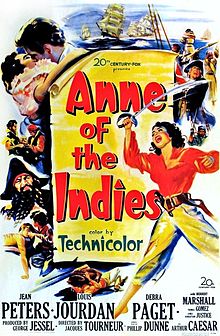
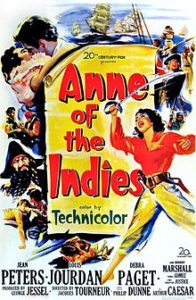 We usually award the title Queen of the Swashbucklers to Maureen O’Hara, but Jean Peters makes a grab for her crown in this fine pirate melodrama. As an orphan girl, Anne (Peters) was raised aboard ship by Edward Teach—Blackbeard himself!—and now commands her own ship, the Sheba Queen, under the name Captain Providence. Since her brother was hanged as a pirate by the English, she preys on English shipping and kills English sailors without mercy, making the captives walk the plank. But one of these captured sailors is the strikingly-handsome Louis Jourdan playing a Frenchman named (what else?) François, who claims to be a privateer’s navigator who’d been captured by the Royal Navy. Captain Providence frees him, adds him to her crew, and takes him to Nassau to meet Blackbeard—which is where the real trouble starts.
We usually award the title Queen of the Swashbucklers to Maureen O’Hara, but Jean Peters makes a grab for her crown in this fine pirate melodrama. As an orphan girl, Anne (Peters) was raised aboard ship by Edward Teach—Blackbeard himself!—and now commands her own ship, the Sheba Queen, under the name Captain Providence. Since her brother was hanged as a pirate by the English, she preys on English shipping and kills English sailors without mercy, making the captives walk the plank. But one of these captured sailors is the strikingly-handsome Louis Jourdan playing a Frenchman named (what else?) François, who claims to be a privateer’s navigator who’d been captured by the Royal Navy. Captain Providence frees him, adds him to her crew, and takes him to Nassau to meet Blackbeard—which is where the real trouble starts.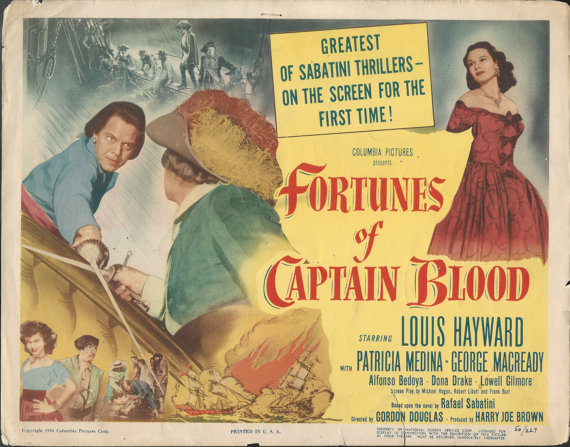
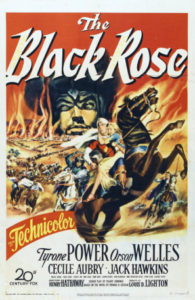 This movie works well as a spectacle depicting 13th-century England and parts of Mongolia and China. As an adventure or character-driven story, however, it’s not so good. This is one of those films in which the angry and stubborn protagonist is told at the beginning what he needs to do to find peace and purpose, spends the next two hours determinedly rejecting that advice, before finally embracing it in the last ten minutes of the picture. Lame! In this case, Walter of Gurnie (Tyrone Power), an illegitimate son of a Saxon lord, is the angry protagonist who’s suffered injustice at the hands of his Norman relatives. Edward II (Michael Rennie)—the King of England, no less—tells Walter he needs to put aside his hatred of the Normans for his own good and that of the realm and its people, but Walter angrily insists on leaving England to seek his fortune in distant lands—in far Cathay, if necessary, which he heard about from his Oxford mentor, Roger Bacon.
This movie works well as a spectacle depicting 13th-century England and parts of Mongolia and China. As an adventure or character-driven story, however, it’s not so good. This is one of those films in which the angry and stubborn protagonist is told at the beginning what he needs to do to find peace and purpose, spends the next two hours determinedly rejecting that advice, before finally embracing it in the last ten minutes of the picture. Lame! In this case, Walter of Gurnie (Tyrone Power), an illegitimate son of a Saxon lord, is the angry protagonist who’s suffered injustice at the hands of his Norman relatives. Edward II (Michael Rennie)—the King of England, no less—tells Walter he needs to put aside his hatred of the Normans for his own good and that of the realm and its people, but Walter angrily insists on leaving England to seek his fortune in distant lands—in far Cathay, if necessary, which he heard about from his Oxford mentor, Roger Bacon.